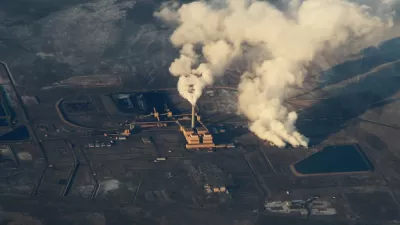The Energy Transition Act passed the New Mexico state House on March 12 and heads to Gov. Michelle Lujan Grisham, the state's new Democratic governor who supports clean energy, but losing a coal plant early causes far-reaching economic impacts.

"The Legislature has moved to Gov. Michelle Lujan Grisham’s desk a controversial bill designed to dramatically increase the amount of renewable energy used to produce electricity in New Mexico while also helping the Public Service Company of New Mexico (PNM) recoup its investments in the coal-burning San Juan Generating Station near Farmington, reports Steve Terrell of the Santa Fe New Mexican. PNM is the state's largest utility.
Following a three-hour debate Tuesday, the House passed Senate Bill 489 by a margin of 43-22. It was a mostly party-line vote, with almost all Democrats in favor of the bill and almost all Republicans voting against it. The measure goes now to Lujan Grisham, who has enthusiastically supported it.
The bill calls for a 50 percent renewable energy portfolio standard in the state by 2030, with a goal of 80 percent by 2040. [It also requires 100 percent carbon-free energy by 2045 for investor-owned utilities, per governor's office].
Closing the San Juan Generating Station, which has been identified as New Mexico’s single largest polluter, in 2022, about 20 years before the end of its useful life, will have a severe economic impact on San Juan County, reported Hannah Grover for the Farmington
The impact of the closure will come from lost taxes, lost jobs and lost investment in the power plant.
A study commissioned by Four Corners Economic Development estimates closing the San Juan Generating Station and the accompanying San Juan Mine, which supplies all the station's coal will lead to more than $105 million in lost wages in San Juan County and nearly 1,500 lost jobs
"The bill would set up a $20 million fund to aid displaced workers and mandates any energy sources that replace the San Juan plant’s output be located in the Central Consolidated School District, which covers about 3,000 square miles," adds Terrell. The school district was identified as a big loser in tax revenue when the plant closes.
After the bill passed the Senate on March 6 on a bi-partisan vote, unlike the House, the governor stated, "With this legislation, our priorities are planted front and center, and, crucially, we do not leave our neighbors in San Juan County behind.”
Western Resource Advocates, representing environmental, labor, and community groups, celebrated the passage of the landmark legislation. In addition to boosting renewable energy production, they noted it would "create jobs, reduce carbon pollution, and diversify the economy in coal-impacted areas."
-
When Red States Turn Blue, February 7, 2019
-
District of Columbia to Adopt the Nation's Strongest Renewable Energy Target, December 23, 2018
-
California May Join Hawaii With 100 Percent Renewable Energy by 2045, August 30, 2018
FULL STORY: Energy bill’s passage portends end of coal era in NM

Trump Administration Could Effectively End Housing Voucher Program
Federal officials are eyeing major cuts to the Section 8 program that helps millions of low-income households pay rent.

Planetizen Federal Action Tracker
A weekly monitor of how Trump’s orders and actions are impacting planners and planning in America.

Ken Jennings Launches Transit Web Series
The Jeopardy champ wants you to ride public transit.

Washington Legislature Passes Rent Increase Cap
A bill that caps rent increases at 7 percent plus inflation is headed to the governor’s desk.

From Planning to Action: How LA County Is Rethinking Climate Resilience
Chief Sustainability Officer Rita Kampalath outlines the County’s shift from planning to implementation in its climate resilience efforts, emphasizing cross-departmental coordination, updated recovery strategies, and the need for flexible funding.

New Mexico Aging Department Commits to Helping Seniors Age ‘In Place’ and ‘Autonomously’ in New Draft Plan
As New Mexico’s population of seniors continues to grow, the state’s aging department is proposing expanded initiatives to help seniors maintain their autonomy while also supporting family caregivers.
Urban Design for Planners 1: Software Tools
This six-course series explores essential urban design concepts using open source software and equips planners with the tools they need to participate fully in the urban design process.
Planning for Universal Design
Learn the tools for implementing Universal Design in planning regulations.
Heyer Gruel & Associates PA
Ada County Highway District
Institute for Housing and Urban Development Studies (IHS)
City of Grandview
Harvard GSD Executive Education
Toledo-Lucas County Plan Commissions
Salt Lake City
NYU Wagner Graduate School of Public Service





























